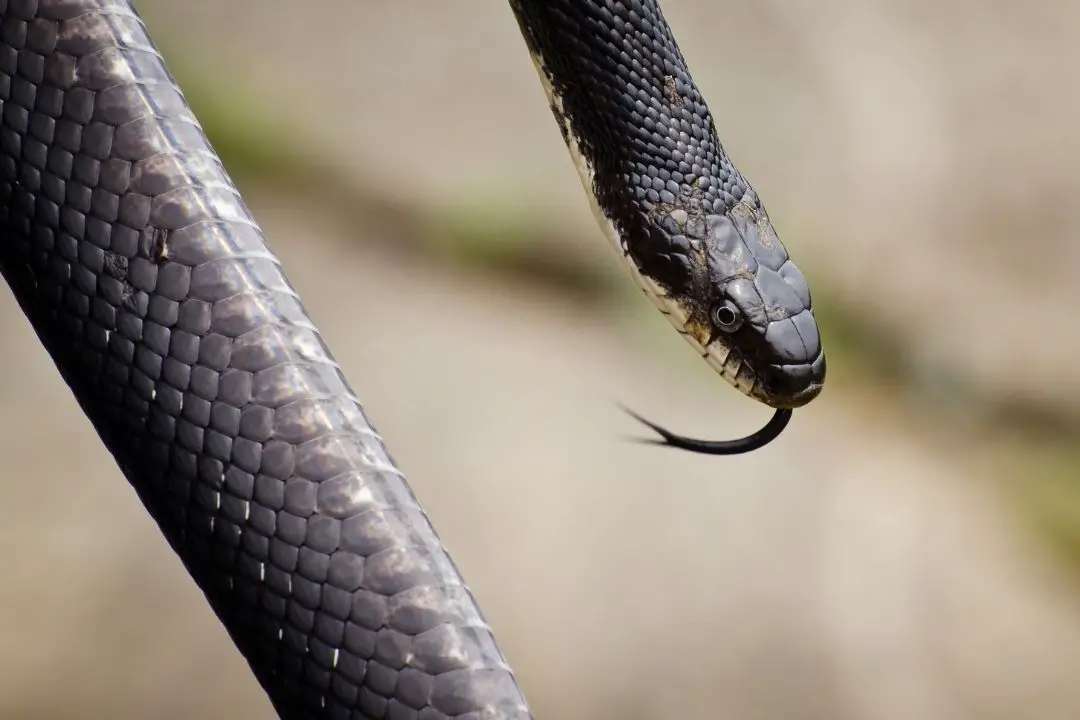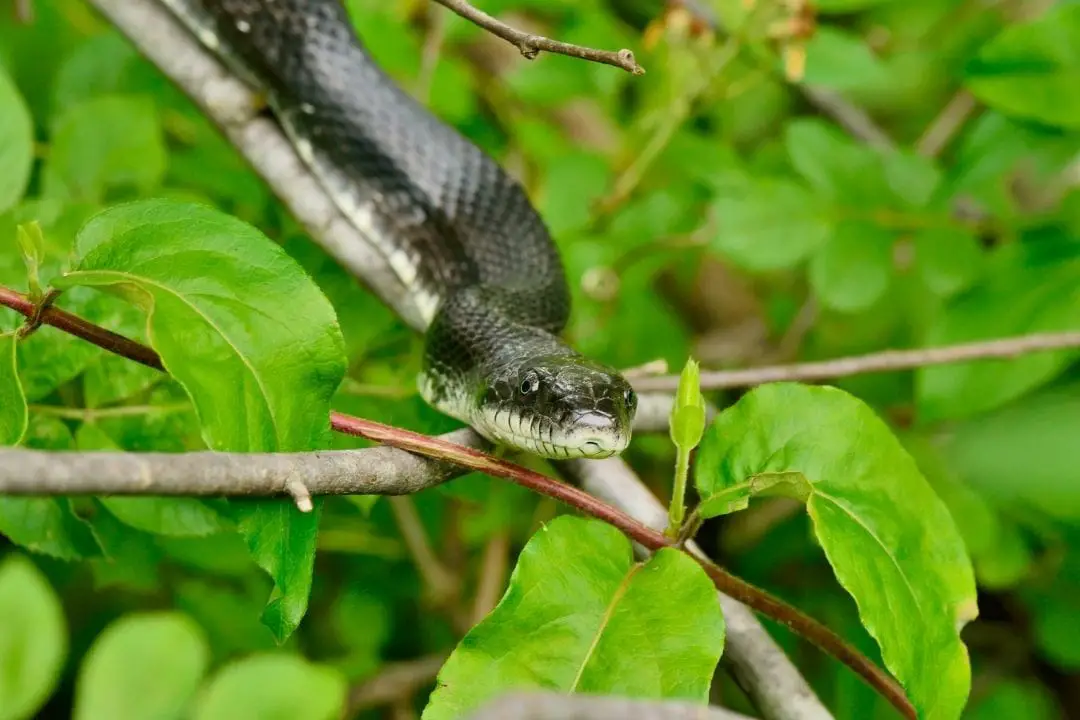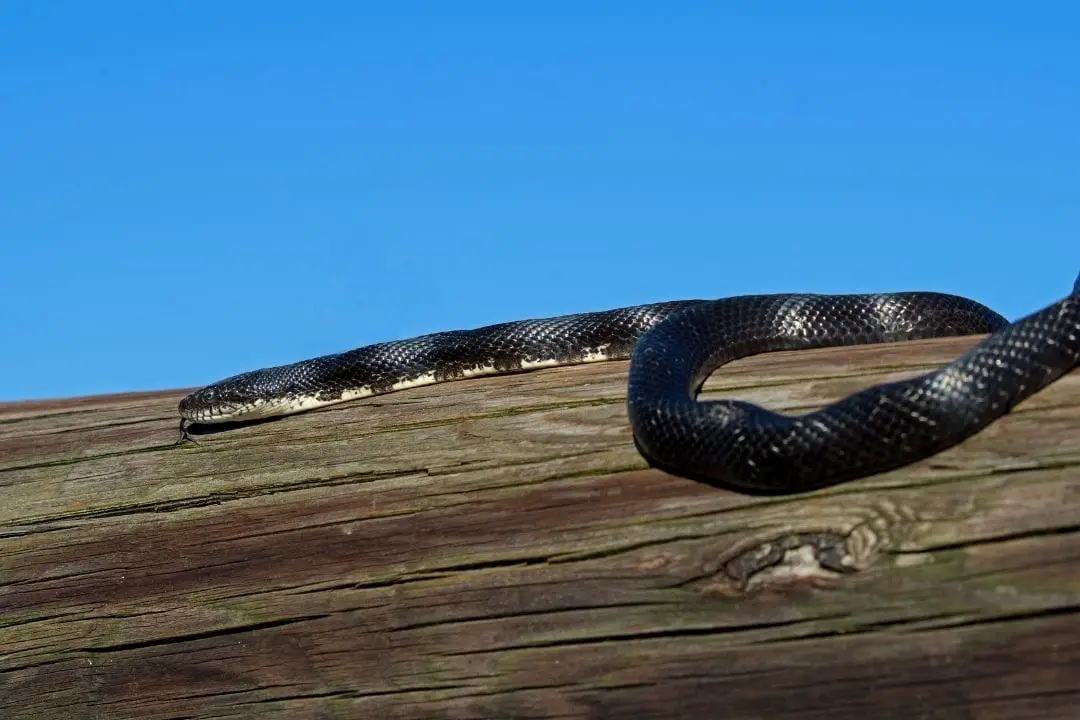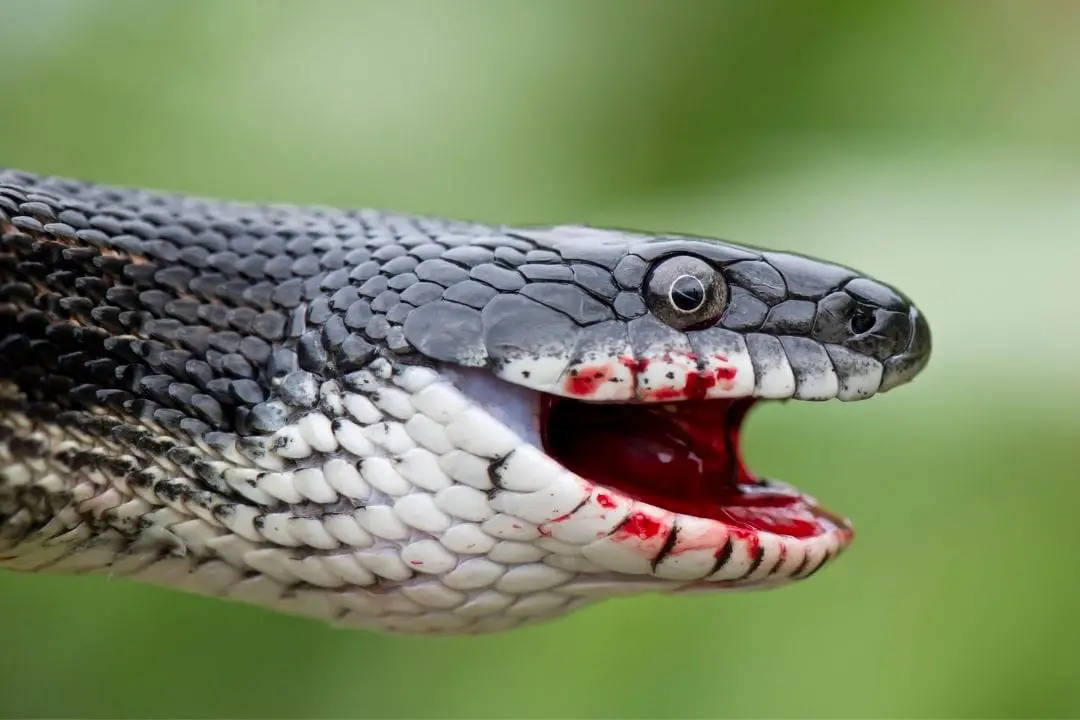The black rat snake (Pantherophis Obsoletus) is known by many names like the black snake, western rat snake, and pilot snake.
The name pilot snake comes from the belief that these snakes lead other snakes to safe burrows to brumate in.
This is not the case, though these snakes will typically spend the winter with both other black rat snakes and other snakes like rattlesnakes and copperheads.
The black rat snake is native to the southern and central United States.
They are typically diurnal aside from the hottest part of summer when they are most active at night. They live in a wide variety of habitats that range from flat farmland to rocky hillsides.
Housing
The first step when it comes to caring for any reptile is to create an enclosure that will meet all of the animal’s needs.
For rat snakes, this means a good temperature gradient, fresh water, sturdy locks, and shelter all in an enclosure that will allow an adult snake to stretch out fully.
Enclosure
The enclosure itself is incredibly important for your snake to stay healthy. It needs to be long enough for the snake to stretch out and have plenty of room for essentials like hides and a large water dish.
It should allow for climbing since these snakes enjoy climbing. These are also active, curious animals so you should try to provide plenty of space for your snake to exercise and explore.
A larger enclosure filled with more hides is always better for a snake. Remember to pick something with a good lock since these snakes are incredibly strong and will try to escape.
Enclosure for Juvenile Rat Snakes
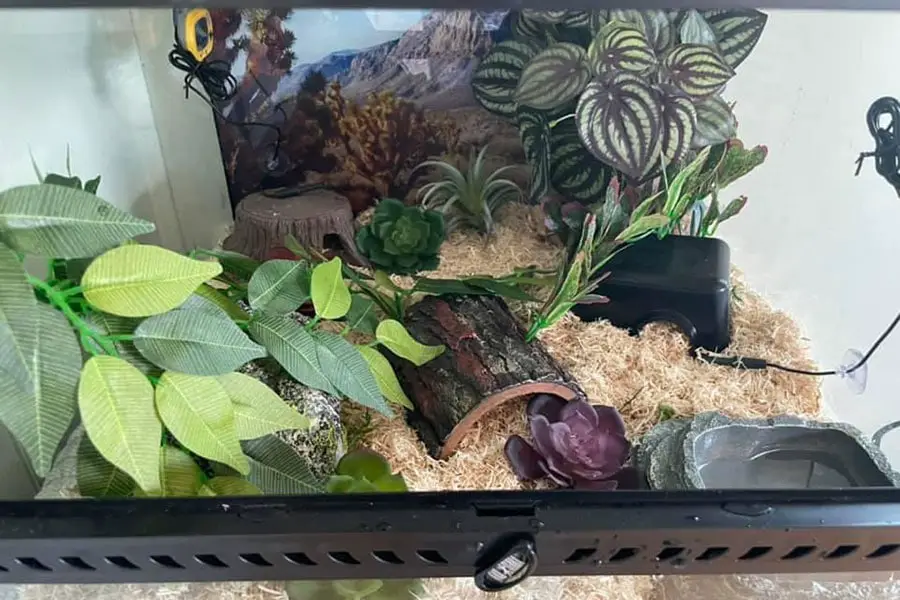
Generally speaking, any enclosure you pick should aim to make caring for your new snake easy.
It should be large enough to accommodate the snake and all the furniture it needs. It should have a secure lock so the snake cannot escape. It should also have an easy way to mount under-tank heating and be easy to clean.
This is a good option for a young snake since they hatch at about a foot long. Once your snake has reached twice the length of your enclosure is when you should change it.
Look for good locks, plenty of ventilation, and front-opening doors. Snakes should be approached from the side and this style of door makes handling a snake easier.
Enclosure for Adult Rat Snakes
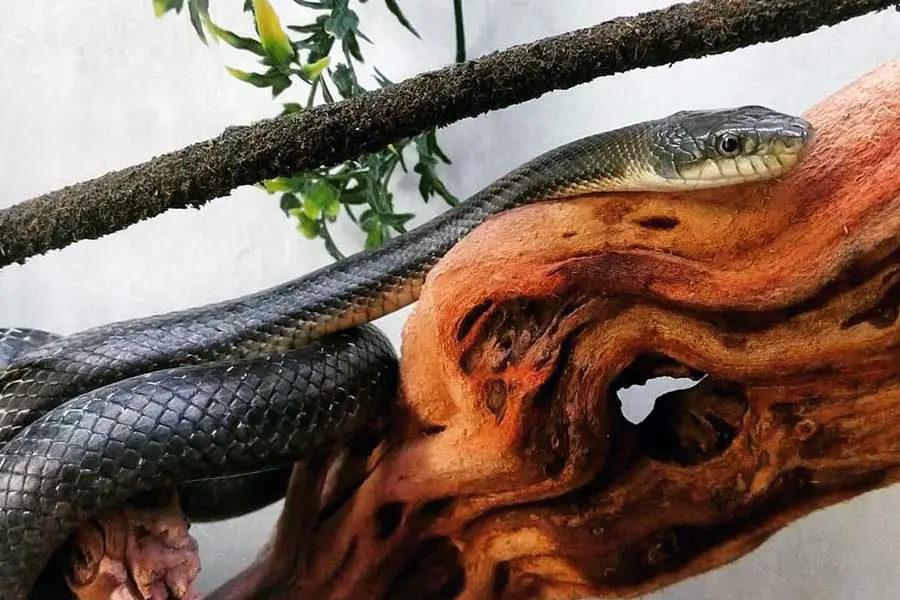
Once your snake has reached its adult size, you should aim to select an enclosure that is at least the same length as the snake. The best formula is full body length for the length of the enclosure and half the length in width and height.
An adult rat snake is typically between 3 and 6 feet so you may need a larger enclosure. These snakes are very curious and will constantly test the enclosure to see if they can escape. Make sure you have good locks to make sure your snake doesn’t disappear.
This is a good enclosure for a small to average-sized individual. It has enough room for a thick layer of substrate, strong locks, and it opens from the front to make handling your snake easier. It also provides access to cable management and an under-tank heater.
Substrate
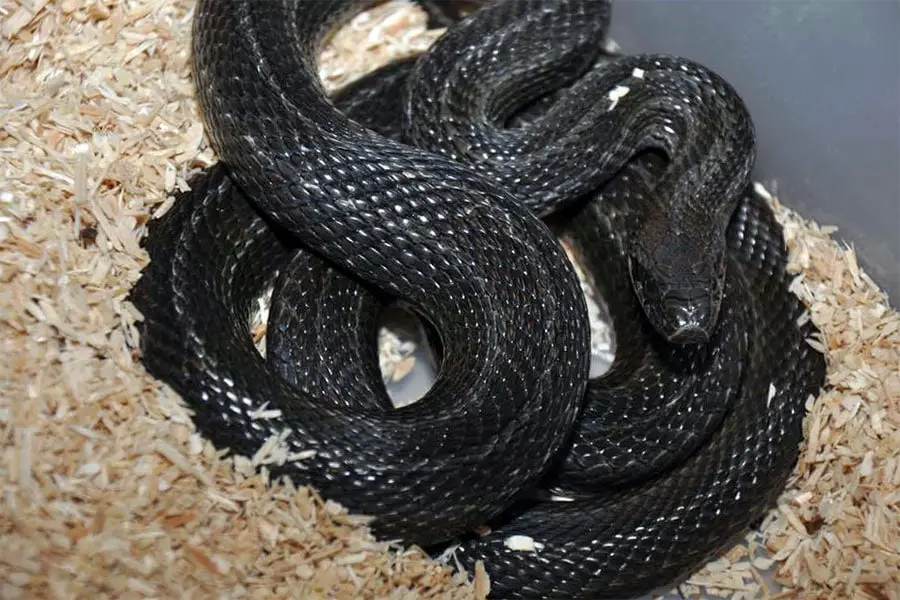
A substrate is important for your snake’s comfort and safety. It helps distribute the heat and makes it easier to clean up the enclosure. You should have a layer of newspaper or reptile carpet as the layer against the bottom of the cage.
This should make sure your snake can’t burrow down and risk overheating on the under-tank heater. Younger animals and new animals should be kept on unprinted newspapers or reptile paper to monitor the animal’s fecal output. Healthy animals that don’t need to be quarantined should be offered a substrate that allows burrowing.
Wood shavings and soil meant for reptiles work nicely.
Do not use pine or cedar, stick with something that isn’t aromatic. Aromatic woods can harm reptiles. Shredded paper can also work well for snakes. Aspen bedding is probably the most common.
Heating
All snakes are ectotherms, which means they rely on outside heat to raise their internal temperatures.
Snakes need to be able to control their body temperature by moving between the zones of a temperature gradient.
Your rat snake should have a temperature on the warm side of about 80-85 degrees. The cool side should be about 75 degrees.
You should try to offer a basking spot that is about 85-88 degrees. All of this can be monitored by a thermometer with the sensors placed about an inch above the substrate in each area.
You should also keep a temperature gun to monitor the surface temperatures your snake will experience.
The best way to provide heat is a heat mat placed underneath the tank on the outside. The temperature can be controlled with a thermostat, it will turn it on and off to maintain the right temperature.
Ceramic heat bulbs are commonly used, but they aren’t the best choice since they can dry out a snake’s enclosure too much, and can burn your snake’s skin if placed improperly. If you are in a cold climate they can help, but be sure to mist the enclosure more frequently.
Light
Snakes do not require special lighting to be healthy. If you would like to add lighting for aesthetics, be sure it doesn’t raise the temperature of the enclosure.
You should also put the lights on a 12-hour timer so your snake can sleep.
Shelter
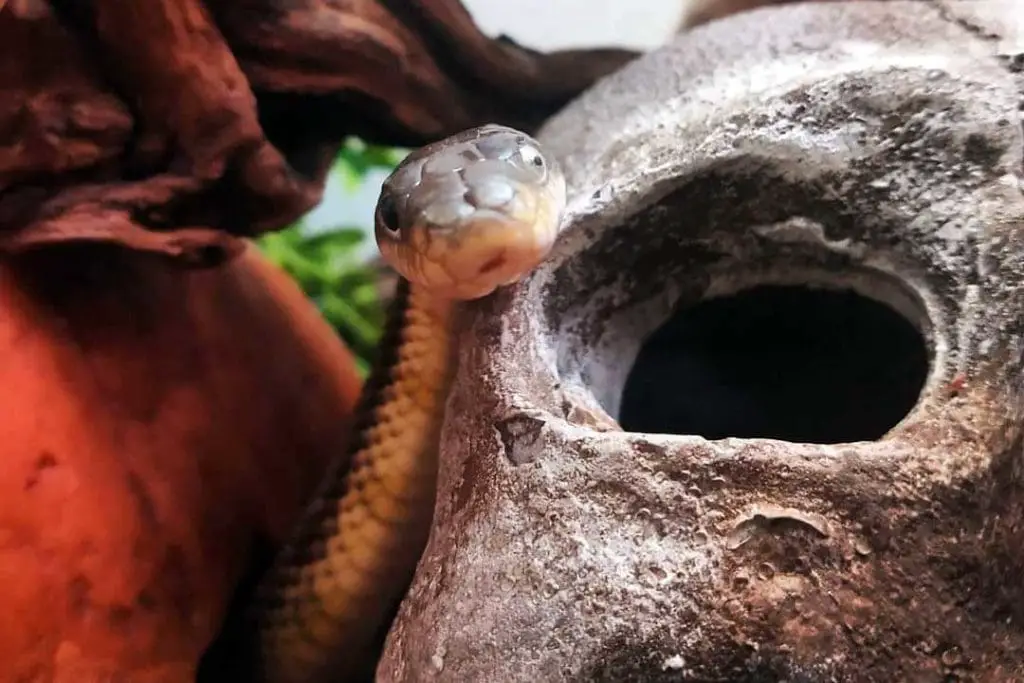
In the wild, black rat snakes are frequent prey for animals like birds and mammals. These snakes prefer staying out of the open whenever possible. Your snake will require you to provide hides to keep them feeling secure.
You will need one on each side of the enclosure so the snake doesn’t need to choose between regulating its temperature and feeling secure.
These snake hides need to have some kind of opening and be just large enough to fit the whole snake without too much extra room.
You can make your own or buy them. Just make sure they are either easy to clean or something you are willing to replace at least yearly.
This is a good example of a snake hide. You can fill the rest of the enclosure with branches, decorations, and other ways to fill the space so your snake doesn’t feel exposed.
Water

Snakes require access to clean water at all times. This is both for drinking and soaking. Many snakes will soak when they are preparing to shed or to help defecation.
When you are looking for a water dish for your snake, you need to keep a few factors in mind.
First, it must be shallow. It needs to fit the whole snake as well. It shouldn’t be easy to tip over because this will flood the enclosure and you will need to replace all the substrate. It should also be easy to clean.
This is a good example of an attractive water dish for your rat snake:
Humidity
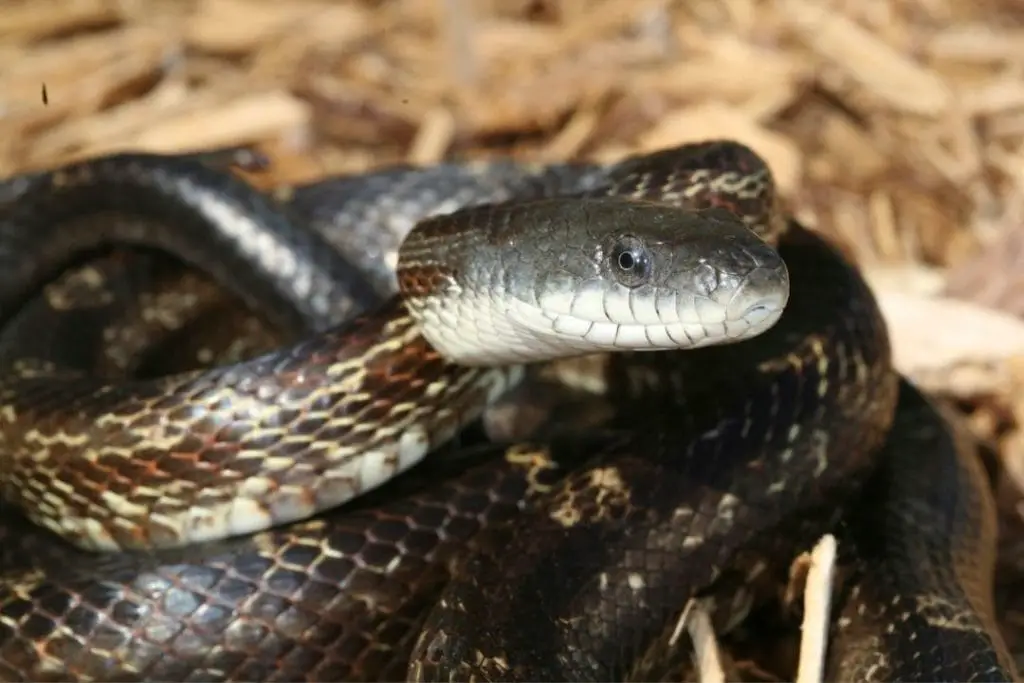
Snakes require a good humidity level for them to shed properly. Black rat snakes prefer 30-60% humidity levels.
You should stay on the lower end and raise it when your snake is getting ready to shed. Regular misting can help keep up humidity levels.
When your snake is preparing to shed, you should offer a hide filled with damp sphagnum moss.
This is a great way to help your snake when it is getting ready to shed. Place it on the warm side of the your rat snake’s vivarium.
Enclosure Maintenance
You will need to keep up on cleaning your rat snake vivarium, this is an important part of keeping rat snakes healthy.
You should check for feces and urates daily. If you find any, spot clean and replace any substrate you removed.
The water should also be changed at least every other day or if it was fouled. You should wash the water dish with hot water and soap once a week. About once a month, you need to do a full cleaning.
This means taking your snake and placing it in a temporary enclosure. A plastic tote with holes drilled in and a secure lid is enough. Just line it with paper towels and maybe a temporary water dish.
Next, turn off the heat and any lighting. You should remove all the decorations and set them aside to be cleaned. Anything that needs to be soaked should have that started now.
Next, remove all the substrate. You should then scrub out the whole enclosure and use a reptile-safe cleaner.
Make sure you don’t spray liquid on hot glass since that could cause it to crack.
Once it is clean, dry it with paper towels and leave it open to finish drying. Then scrub all the decorations and hides. Make sure the water dish is sanitized.
Finally, replace all the substrate and decorations and turn the heat back on. Place and fill the water dish before returning your snake and locking the enclosure securely.
Feeding
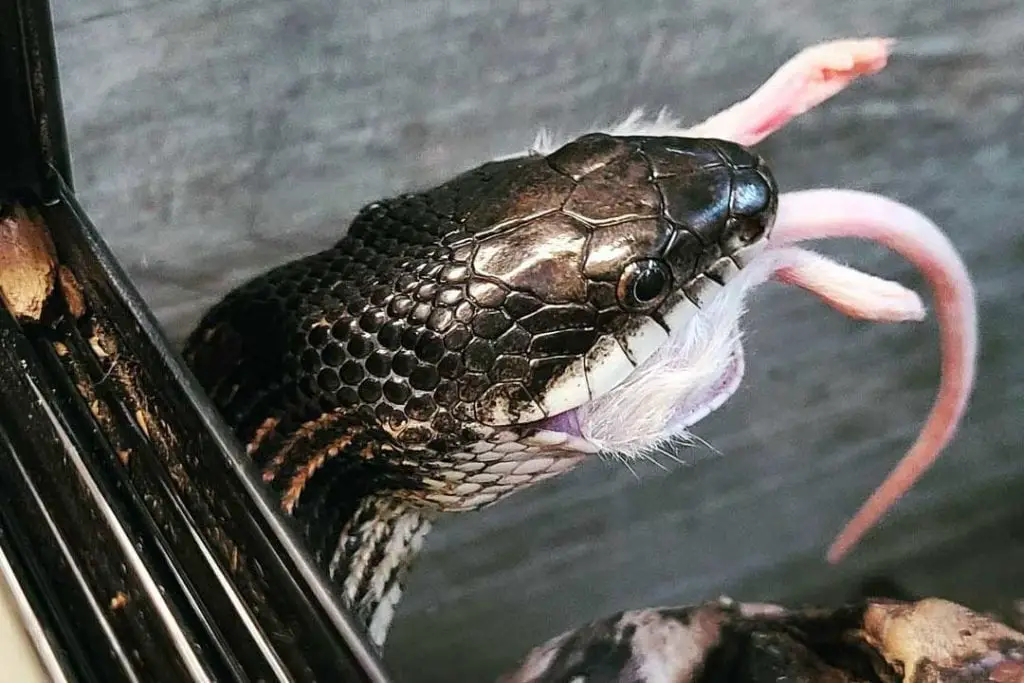
All animals need to eat. In the wild, black rat snakes eat rodents, amphibians, lizards, and eggs.
Type and Size of Prey
In the wild, they mostly eat rodents, amphibians, and the occasional bird egg
In captivity, you will be feeding your snake mice and small rats for larger animals. You should size the prey to match the widest part of your snake. You can also feed by weight.
A snake can eat prey that is about 10-15% of its body weight.
Use a kitchen scale that measures in grams for an easier time. Hatchlings will likely eat a pinkie or newborn mouse. This will size up with your snake.
Look for a small lump after feeding. This should go away within 36 hours. If you do not see a lump, you need a larger prey item next time.
If the lump takes longer to go away you should size down. Make sure your snake is growing steadily for the first 2 years of its life and maintains weight as an adult rat snake.
Frozen vs Live

The frozen or live food debate is a large one in the reptile community. We will go over the pros and cons of each quickly.
Live Pros:
- Allows for natural behaviors
- More nutritious
- Easier to get picky animals to eat
Live Cons:
- Risk of injury or death to the snake
- Snakes that have not been fed live prey won’t take it
- Risk of parasites
- Expensive
- Have to house the mouse if your snake refuses to eat
- Have to locate live mice in the right size
Frozen Pros:
- Easy to find
- No risk or injury or parasites
- Can order online and have shipped to your house
- Can find them in any size or color needed
- Easy to store
- Can buy in bulk to save money
- Most snakes will take frozen food easily
Frozen Cons:
- Slightly less nutritious
- Have to thaw
- You need to handle the mouse more
- Some snakes won’t take pre-killed food
Frozen prey is typically safer for the snake. If your snake is eating adult mice there is a real risk of injury. Rats are typically known to cause more severe injuries as well.
To feed a live mouse, you just need to place the mouse in the enclosure and watch until the animal is subdued and consumed.
To feed frozen, place one prey item in the fridge the day before you want to feed. About an hour before you want to feed your snake, place the mouse in a BPA-free bag and place it in warm water until the mouse is around 100 degrees.
Then you can offer the prey to your snake with feeding tongs. You can move the mouse around to convince the snake to take a strike at it.
When it comes time to buy food, finding live prey for adult snakes is more difficult. Live rodents cannot be shipped. You need to acquire them from a reptile supply store or reptile show.
Call ahead to make sure they have the right size of feeder mouse. You can also check Facebook and Craigslist for feeder mouse breeders who have some for sale.
Frozen prey can be bought in a pet store, at a reptile show, or you can order it online. I recommend Micedirect, but Perfect Prey, Big Cheese Rodents, Layne Labs, and Rodent Pro are all good sources.
How Often to Feed
Hatchlings need to eat every 5-7 days. Juveniles over a year will eat every 7 days. An adult black rat snake will eat every 7-10 days. Watch your snake’s weight and body condition to determine if you need to change how often you offer food.
Shedding
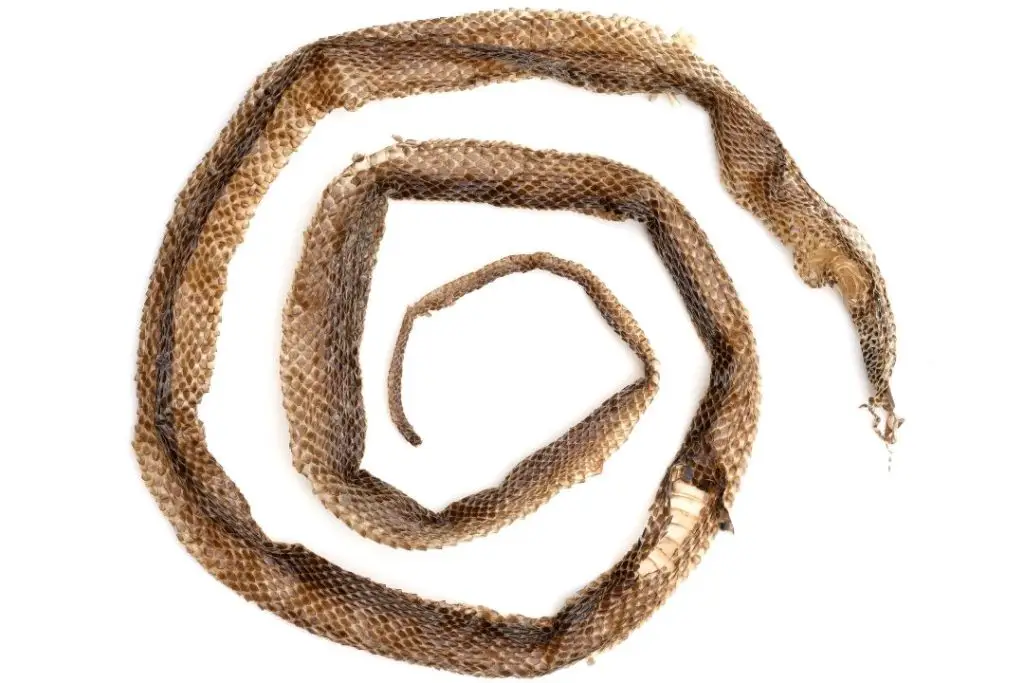
Shedding is how a snake grows. Unlike humans, snakes shed all their skin at once to make room for more growth. A hatchling may shed every month or so, but an adult may only shed 2 or 3 times a year.
Your snake will have a duller look and cloudy eyes while they prepare to shed. This is a fluid buildup that separates the old skin from the new skin.
Texas rat snakes are typically grumpy and will refuse to eat at this time. You should up the humidity and offer a humid hide filled with damp sphagnum moss as soon as you notice your snake is beginning to shed. This can just be any container with a lid that will hold your snake.
Cut a hole to allow it to crawl in and fill it with moss that is moist but not wet. Place this on the warm side of the enclosure. After a few days, your snake will look clear. The snake will start rubbing on branches to dislodge the old skin.
Once it is shed check that it is intact. Pay attention to the eyecaps that protect your snake’s eyes and the tail tip. If you notice any stuck shed, place your snake in a container with a warm wet paper towel.
Wait half an hour then try to remove any stuck shed with tweezers. Do not force it if it won’t detach, just repeat the treatment. A stuck shed can cause injuries and infections so it must be removed promptly.
Hibernation
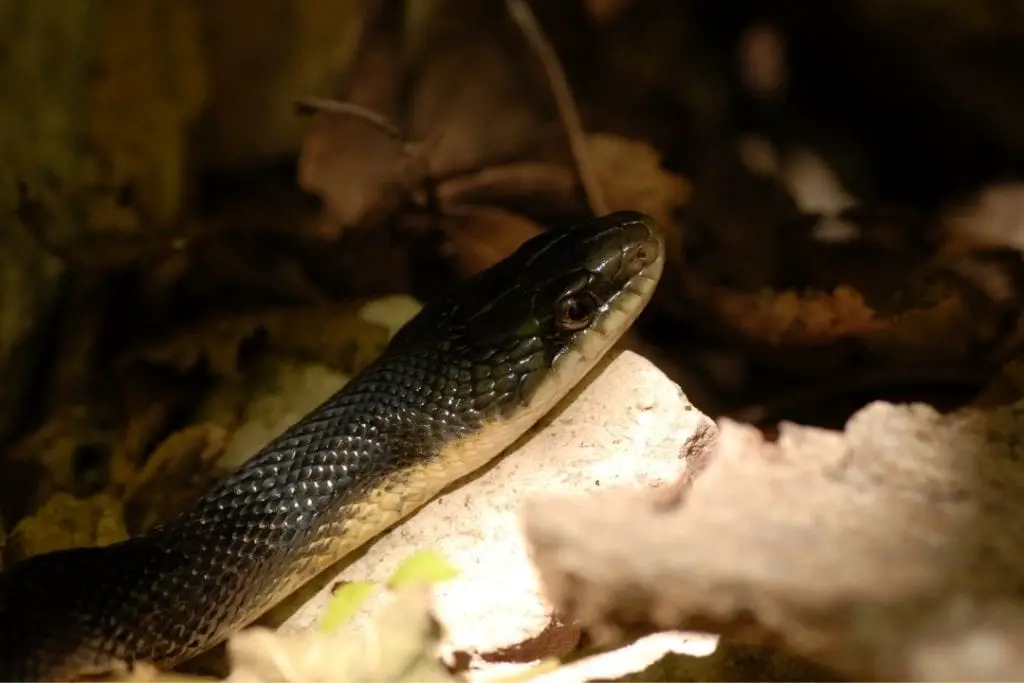
North american rat snakes like the black rat snake go into a state known as brumation when the weather gets cold. The animal will spend most of its time asleep but will wake up occasionally to do things like drink water.
This is caused by dropping temperatures and lower light levels.
Similar to corn snakes, you do not need to induce brumation unless you will be breeding pet snakes. Your snake may eat less during winter due to less light or slightly lower temperatures.
Handling
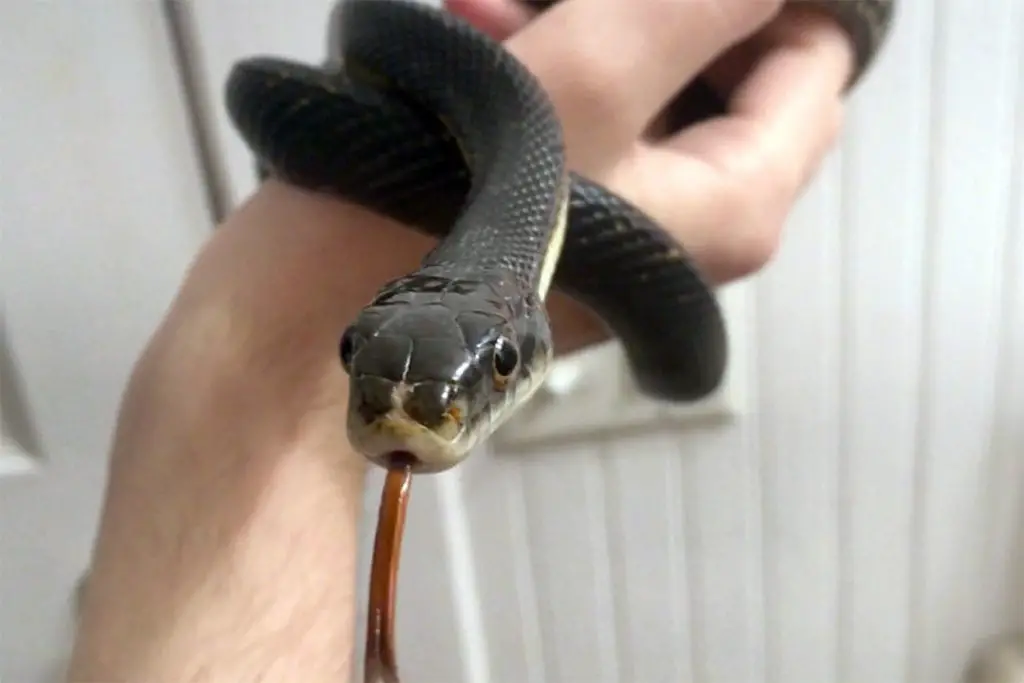
Handling is important to make sure your snake won’t fuss for basic care needs like cleaning the enclosure or taking it to the vet. You should let new snakes settle for at least a week before you try to handle them.
You should also not handle your snake for 2 days after a meal. Once you are ready, make sure your snake is awake and aware of you.
Make sure the animal isn’t scared or trying to defend itself. Then you can approach them from the side and gently lift them by slipping a hand under the mid-body of the animal.
Support as much of the animal as you can as you remove it from the enclosure. Handle the snake for about 10 minutes or until it relaxes. Then you can put it back.
Always put the snake back once it is relaxed so it doesn’t learn that being aggressive will get it put back. Handle 2 or 3 times a week. Make sure your snake isn’t getting stressed from overhandling.
Signs of stress in pet rat snakes include aggression and lack of appetite. If your snake bites you, be sure to stay calm. Do not attempt to pull the snake off of you, especially a baby snake.
This will make your injury worse and can break the snake’s jaw or teeth. Wait until it releases and return the snake to the enclosure.
Baby snakes are usually more nervous, but most rat snakes will not be too agressive compared to many other snake species and tend to calm down as the snake matures.
Black rat snake bites are typically not much worse than being scratched by a cat, similar to a corn snake bite. Just wash the wound and apply an antibiotic ointment.
Common Issues
My Black Rat Snake Isn’t Eating
Texas rat snakes can stop eating for a number of reasons. One of these is simply that your snake isn’t hungry. If it hasn’t defecated yet then it won’t want to eat. If the snake is shedding it won’t eat, and many snakes naturally eat less during winter.
Captive snakes can also be picky. If the prey is a different color, some snakes won’t recognize it as food. Be sure to check your temperature and humidity levels since snakes won’t eat if the temperature won’t allow quick digestion.
Check your snake for any infections or illnesses. If you feed live prey, your snake may have been injured by the last meal. Check for excess mucus, wheezing, or other odd sounds.
If your snake has a lump in its stomach when it has not eaten, then it may have parasites. Head to a reptile vet if you see any of these signs.
Regurgitated Food
If your snake is regurgitating its meals, this is a bad sign. Regurgitation can kill a weak snake. Make sure you don’t handle your snake after a meal and be certain the snake is getting the right size of prey.
Snakes will regurgitate a meal if it is too large. If it happens more than once, head to the vet. Illness can cause snakes to be unable to keep a meal down.
Respiratory Infections
Respiratory infections are one of the most common captive rat snakes illnesses. Signs of infection include excess mucus, breathing through the mouth, labored breathing, and strange sounds like wheezing or clicking.
You may also notice mucus coming through the nostrils. If you notice the signs, take your snake to a reptile vet. Infections are easily treated if caught early.
Conclusion
Now you should know how to keep your black rat snake happy and healthy. If you have any questions or comments, leave them below. We hope you enjoy your new companion.
Sources
- The Ratsnake Mess for Dummies – Herpetology Unit (make sense of rat snake species)
- Ratsnakes facts – livescience
- Pantherophis obsoletus – Wikipedia
- Rat Snake (Elaphe [Pantherophis] obsoleta) – Savannah River Ecology laboratory
- Natural History of the Black Rat Snake (Elaphe o. obsoleta) in Kansas – Henry S. Fitch
- A Taxonomic Investigation of the Black Ratsnake, Elaphe o. obsoleta (Say) [Reptilia, Squamata, Colubridae], in West Virginia using Morphometric Analyses – Adam M. Mann
